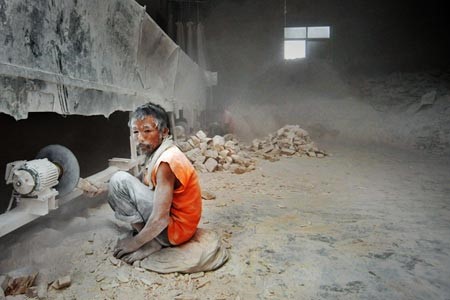
This workplace’and worker’are covered in plaster dust. What kinds of safety hazards does this dust pose’

Dust from wood, metal, plaster, lead and other sources poses several kinds of serious safety hazards in the workplace. For example, if the dust is combustible, it can catch fire and even explode. And without proper safety measures, workers can inhale dust and develop various respiratory conditions. Exposure to dust can also aggravate existing conditions, such as asthma, emphysema or bronchitis.
In this picture, the worker is covered in plaster dust. In fact, the entire workplace appears to be covered in dust. But he’s not using a respirator or other PPE and there doesn’t seem to be adequate ventilation, housekeeping practices or safety measures to address this hazardous dust buildup.
This worker was one of 11 escorted home after the media reported on their unhealthy working conditions. Authorities shut down the plant and fined the factory owner the equivalent of $3,150 (US). But no criminal charges were expected against the owner because the workers weren’t forced to work and their freedom wasn’t restricted.
Take 3 Steps to Select Proper Respiratory Protection
The best way to ensure compliance with the respiratory protection requirements in the OHS regulations is through a respiratory protection program. One element of that program should cover the selection of appropriate respiratory protection, which should be used if you can’t eliminate dust and other respiratory hazards through engineering controls, such as ventilation systems.
How do you know which type of protection is appropriate’ Follow these three steps:
Step #1: Conduct an assessment to determine the kinds of respiratory hazards that exist in the workplace or with regards to a particular job. Different kinds of respiratory hazards require different kinds of respiratory protection. For example, oxygen deficiency must be handled differently than exposure to an airborne contaminant such as dust. Even different airborne contaminants require different kinds of protection. And the same airborne contaminant may require different types of respiratory protection depending on its level or concentration.
Step #2: Select appropriate respiratory protection. Use the information gathered in the respiratory hazard assessment to determine which kind of respirators would be appropriate for workers exposed to the identified hazards. Because selecting appropriate respirator protection is complicated, use of a respirator selection flowchart is recommended. You can also use this respiratory protection selection form to choose the right respirator and document how you made that choice.
Step #3: Ensure chosen respirator is appropriate for the worker. The respirator you’ve selected may be appropriate for the respiratory hazards but it must also be appropriate for the workers who’ll use it. For example, a respirator won’t protect a worker if he has a health condition that impacts his ability to wear a respirator or use a specific type of respirator.
So before workers use the respirators you’ve selected, make sure that they don’t have any medical conditions (physical or psychological) that could affect their use of this equipment. For example, breathing through a respirator with a filter takes more effort than normal breathing.
You should also conduct fit tests on workers who’ll use the respiratory protection. Respirators won’t protect workers if they don’t fit properly. So before a worker uses the respirator you’ve selected for him, conduct a fit test and document that you’ve done so and the results of the fit test. (Use this form to document the results of workers’ fit tests.)
